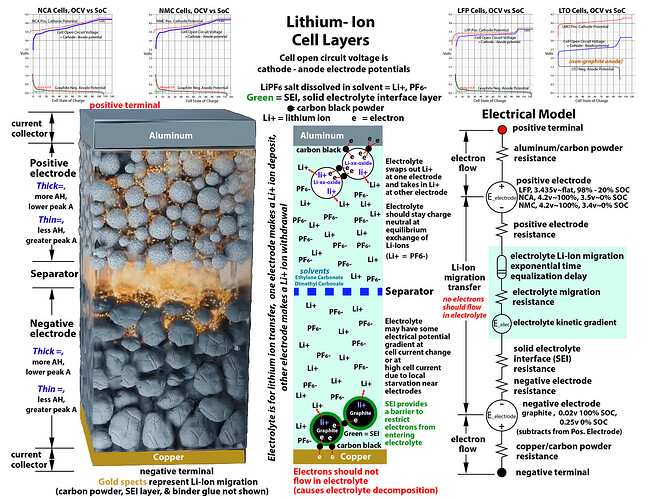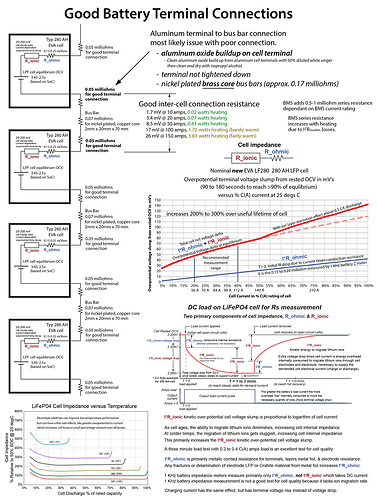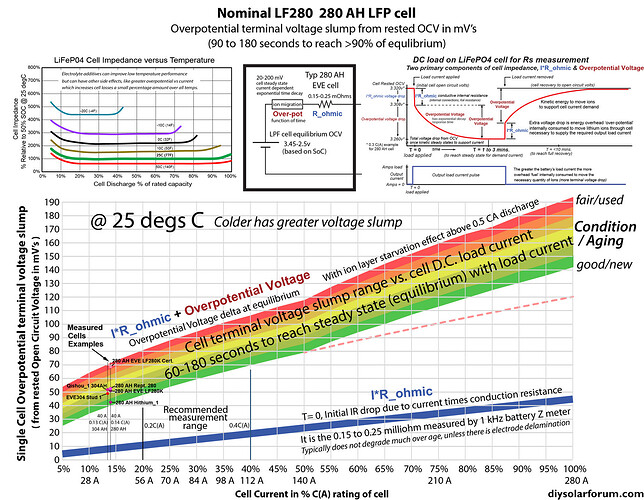Geballtes DIY System Wissen mit alle Komponenten und Erklärungen - sehr umfangreich
Dies ist die zweite gute "Kapitäns Quelle" neben Nordkyndesign: marinehowto. (free source of information)
1. Dieser Artikel benennt viele schwarze Schafe und die Folgen. Sehr umfangreich: (nix fürs Handy)
https://marinehowto.com/drop-in-lifepo4-be-an-educated-consumer/
The act of holding LFP batteries at or near 100% SOC can only serve to slowly harm them and eat away at cycle-life. An LFP cell can achieve 100% SOC at just a bit over 3.4 VPC (13.6Vpack voltage) if you’re battery manufacture suggests anything over 13.6V for float you may want to reconsider that and set it below 13.6V .You can always set it lower but should not go higher....
Hier steht explizit wie eine LFT Zelle behandelt werden soll: sie soll geladen werden und dann entladen werden .Punkt. NIX ANDERES ZWISCHENDURCH. Macht aber keiner hier - oder ?: VICTRON BIETET ES (bis SOC 50% ) an :
....There are charger manufacturers out there who actually understand charging LFP batteries.Victron is about the best known. Victron has a specific setting in their custom menu that allows you to set a “storage” voltage this is a voltage the charger drops to after a short float has been done. It can be custom programmed to allow the batteries to self discharge down to about 50% SoC before the charger kicks back in and maintains the “storage voltage.”the only chargers or inverter/chargers we currently recommend for lithium iron phosphate batteries are Victron.... ?
Cut Off Current:
.........When at 13.8V – 14.2V and charge current has fallen to 5% of installed Ah Capacity all charging MUST STOP......
(ist hier eine andere Methode als die (Hersteller abhängigen !!) Tabellen von Nordkyndesign. )
Der Pack soll auf keinen Fall lange oben gehalten werden:
......#9 Understanding Cycle Life Claims – When an LFP cell manufacturer rates a cell at 2000 100% DoD cycles this is; charge to target voltage, stop immediately once you hit that voltage, discharge to the low voltage threshold, repeat, repeat, repeat. If this target voltage for cycle life testing is 14.6V they charge to 14.6V, stop immediately and discharge. These cells, at this rating, are not held at a the target voltage for cycle-life testing. In other-words you may not get the claimed cycles using a lead acid charger that holds an absorption cycle timer orcharges differently than the way the cells were tested...
2. wichtiger Artikel.
ja etwas kurz - der obige Artikel.
wer es nun etwas genau wissen will - voila: meine Lieblingsquelle - besonders auch wegen der Bilder. Weiter unten geht es ums Thema. vorsicht: z.T. Winston Zellen mit höheren Spannungen!
https://marinehowto.com/lifepo4-batteries-on-boats/
DIY LiFePo4 On Boats (update 26.3.2023)
.........
Please, I ask anyone reading this article to present me any credible scientific data that shows why going above13.8V – 14.0V or 3.45VPC to 3.50V per cell is good for the batteries? I would honestly like to hear any solid scientific reason why it is necessary to do this on each cycle? Thus far the only reason I have had, from actual battery researchers, is this: “Most DIY’s simply won’t be starting out with “well matched cells” unless buying from a reputable dealer because they don’t have the test equipment to ensure this.”
I fully accept that argument! This is why I always preface anything having to do with a DIY build with “with well matched cells”…
I have nearly 150 research/white papers in the CMI data-base and not a single one of them gives any good reason to push these cells into the upper knee with regularity. Not a single one.
Alle Artikel Marinehowdo:
https://marinehowto.com/
Alle 6 LFT Artikel Nordkyndesign:
https://nordkyndesign.com/category/marine-engineering/electrical/lithium-battery-systems/
###################################################################
Aber jetzt zur Sache - was haben diese Leute denn noch herausgefunden ?
-
- einige Hersteller (BMS und Akku) haben diese Dauer Höchstspannungen erst aus ihren Datenblätter herausgenommen, nachdem die Zellen der Kunden haufenweise schwanger wurden. Und jetzt schaut bitte ganz genau, was euer BMS Hersteller oder Systemadministrator empfiehlt !
-
- was bedeutet dieses banale "nur laden und dann entladen" (siehe EVE Datenblatt. Keine Ladespannung von 3,65V auf Dauer) eigentlich ? Nun - es sollte (darf) bei LiFEPO4 keinen FLOAT geben !!! uuuups. Siehe oben den lobenden Hinweis auf VICTRON. Der Hintergrund ist, dass bei Float die Chemie ja immer wieder in beide Richtungen wandern muß. Ab und zu erfolgt ja bei Float eine Entladung und dann wieder Ladung. Diese immer umkehrenden Chemiewanderungen mag LiFEPO4 gar nicht - logisch. Auch ohne FLOAT dürfte es beim Entladevorgang keinerlei Ladung geben - und umgekehrt.
Also richtig wäre: laden - ohne (umkehrende) Entladung zwischendurch und dann entladen - ohne (umkehrende) Ladung zwischendurch. Und zwar im gesamten Bereich 10% SOC bis 90% SOC. Punkt (jooo - dasss dies keiner machen will, ist mir auch klar)
Was heist dies nun für unsere PV und LiFEPO4 Akkus und unser "bitte aber möglichst voll" oder wenns gut läuft :"mindestens halb voll denken":
Überspitzt: Sorry - dafür (PV) ist LiFEPO4 eigentlich nicht geeignet. (ok - aber es gibt nichts besseres - und die kleinen Schäden sind eher langfristig)
Float doch verwenden: Eine Mögliche Annäherung an PV Systeme: die 6 Punke von unten: den Float ganz tief setzen,
Considering that the biggest issue is the absence of correct charge termination, one approach can be giving up altogether on absorbing the battery when it is not possible to do it properly:
- at least one charging source is capable of performing a full charge with correct termination based on residual battery current every time; and
- this source (which can be the engine alternator for example) is used occasionally; and
- all the other charging sources are programmable and can be configured to skip absorption, so they just switch to “float” immediately when the absorption voltage gets hit; and
- there is nearly always a load on the installation, so the bank doesn’t get partly charged and then rested; and
- the “float” voltage can be configured low enough to ensure the battery will nearly always discharge; and
- these sources do not restart charging before the bank has been able to discharge meaningfully,



